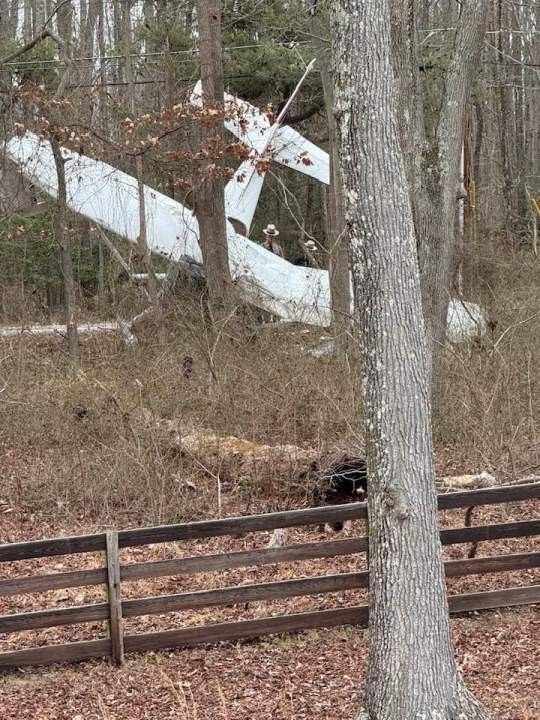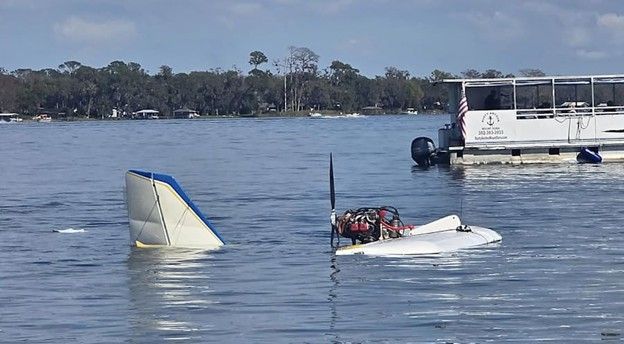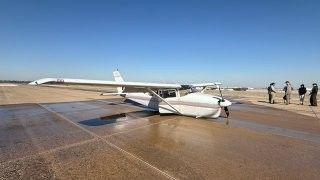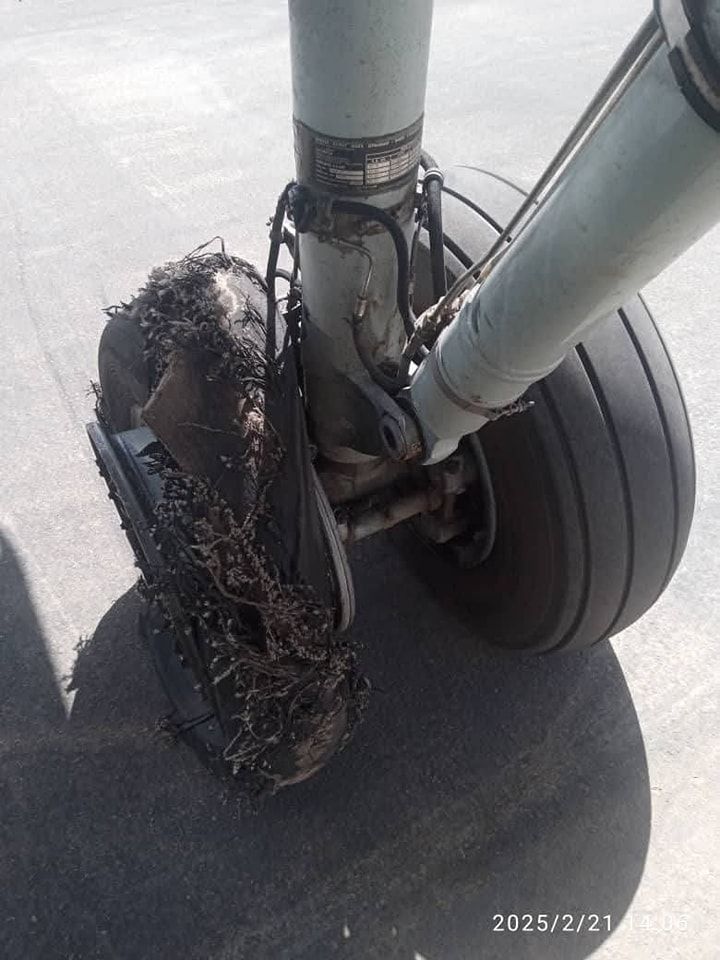ARFF Daily News
Published on:
Monday the 24th of February, 2025
18-year-old pilot operating single-engine plane makes emergency landing in Anne Arundel County, police say
by: Paola Belloso
ANNE ARUNDEL COUNTY, Md. (DC News Now) –Maryland State Police (MSP) said an 18-year-old pilot operating a single-engine plane made an emergency landing in Mayo, Maryland on Saturday afternoon.
MSP said that just before 4 p.m., police responded to Triton Beach Road and Shoreham Beach Road for the report of a plane crash.
Police said that the investigation found that a single-engine Cessna aircraft lost power and made an emergency descent.
The 18-year-old pilot was taken to the hospital to be treated for their injuries.
The Anne Arundel County Police Department is helping with closures.
Fire and EMS crews as well as the National Transportation Safety Board (NTSB) and the Federal Aviation Administration (FAA) responded.
The investigation is active.

2 injured after seaplane crashes into Lake Dora near Tavares, deputies say
Incident happened on Lake Dora
TAVARES, Fla. – Two people on board a seaplane were injured after it crashed in Lake Dora on Sunday, according to the Lake County Sheriff’s Office.
Deputies said the ultralight seaplane went down in the middle of the lake on the downtown Tavares side.
According to the sheriff’s office, one person sustained minor injuries and the other was taken to the hospital with facial injuries, but both are expected “to be ok.”
Deputies said they have contacted the National Transportation Safety Board to investigate.

Two in-air aircraft emergencies at Arlington airport on Saturday, officials say
Airport authorities say no injuries were reported for either incident
By Lauren Harper
All passengers are OK after two aircraft emergency landings on Saturday at the Arlington Municipal Airport, according to the airport's fire department.
First responders were en route to the first emergency, a plane experiencing engine trouble while in the air that landed safely when a second in-air emergency was reported at about 2:45 p.m.
The second aircraft, a fixed-wing single-engine CESSNA 210C transporting three people, reported that its landing gear would not deploy.
Arlington fire said after circling the airport to burn excess fuel, the pilot performed a "very smooth and uneventful" belly landing, defined as a landing without the proper gear lowered.
City firefighters, EMS, police officers and airport employees were called to assist in the emergency. Arlington fire said the underside of the aircraft was sprayed with water once it came to a stop as a precautionary measure.
Authorities said no injuries were reported in either incident. Additional information for the first emergency was not released.
The airport was closed several hours after the incident while the National Transportation Safety Board conducted a routine investigation.
https://www.nbcdfw.com/news/local/arlington-airport-reports-two-in-air-aircraft-emergencies-over-weekend/3776109/

Landing Gear Tire Explodes During Takeoff of Passenger Plane
The passenger plane's landing gear tire burst during takeoff.
One of the landing gear tires of the De Havilland Canada Dash 8-400 type passenger aircraft , registered 7T-VCO, operating the flight number SF2333 from Tamanrasset to In Salah Airport, belonging to Tassili Airlines, an Algerian passenger airline company based in Algeria and owned by Algeria’s national state oil company Sonatrach, burst during take-off.
Following the incident, the pilots decided to return. After a safe landing, it was learned that the plane was taken into maintenance and the flight was cancelled.
https://www.goklerdeyiz.net/yolcu-ucaginin-kalkisinda-inis-takim-lastigi-patladi/

NTSB Final Report: Composite FX Mosquito XE
The Total Loss Of Engine Power And Subsequent Impact With Terrain During An Autorotation
Location: Waco, Texas Accident Number: CEN25LA038
Date & Time: November 11, 2024, 14:40 Local Registration: N869DJ
Aircraft: Composite FX Mosquito XE Aircraft Damage: Substantial
Defining Event: Loss of engine power (total) Injuries: 1 Minor
Flight Conducted Under: Part 91: General aviation - Personal
Analysis: The pilot stated that while returning to the airport, the helicopter’s engine rpm dropped to zero with no warning. He initiated an autorotation and aligned the helicopter to touch down in an open field but noticed powerlines as he got closer. The pilot maneuvered away from the field and aimed for a clearing in a residential backyard. The main rotor blades impacted a tree, and the helicopter fell about 15 ft to the ground before it came to rest on its right side. The helicopter sustained substantial damage to the fuselage and main rotor blades. According to maintenance records, the engine was removed and replaced about a month before the accident. Additionally, a condition inspection was completed by the owner four days before the accident during which he changed the spark plugs and adjusted the fuel mixture.
A post-accident examination revealed corrosion at the radiator fill tube connection and a loose band clamp. Additionally, the engine exhibited signatures consistent with being operated at a temperature above the normal operating temperatures and evidence of piston seizure due to thermal expansion.
Probable Cause and Findings: The National Transportation Safety Board determines the probable cause(s) of this accident to be -- The total loss of engine power and subsequent impact with terrain during an autorotation. Contributing to the accident was the improper sealing of the liquid cooling system.
FMI: www.ntsb.gov
NTSB Final Report: Starship Enterprise (No, Really)
Pilot Discovered Two Through Penetrations Of The Ventral Vertical Stabilizer And Damage To Three Propellor Blade Leading Edges
Location: Addison, Texas Accident Number: CEN25LA020
Date & Time: October 17, 2024, 16:00 Local Registration: N903SC
Aircraft: Starship Enterprise Aircraft Damage: Substantial
Defining Event: Collision with terr/obj (non-CFIT) Injuries: 1 None
Flight Conducted Under: Part 91: General aviation - Personal
Analysis: While conducting a post-flight walkaround inspection, the pilot discovered two through penetrations of the ventral vertical stabilizer and damage to three propellor blade leading edges, likely from foreign object debris. The stabilizer sustained substantial damage. The source of the debris could not be determined based on the available information. The pilot reported that there were no preaccident mechanical failures or malfunctions with the airplane that would have precluded normal operation. This airplane is an exported former Beechcraft Starship 2000A that was issued a new special airworthiness certificate as an experimental Enterprise during import.
Probable Cause and Findings: The National Transportation Safety Board determines the probable cause(s) of this accident to be -- Foreign object debris damage to the ventral stabilizer. The source of the debris could not be determined based on the available information.
FMI: www.ntsb.gov
NTSB Final Report: Powrachute Sky Rascal
Aircraft Rolled Over During Touchdown Causing The Pilot To Put His Hand Out To Stop The Roll Which Resulted In A Broken Arm
Location: Peculiar, Missouri Accident Number: CEN25LA011
Date & Time: October 6, 2024, 18:15 Local Registration: N2565Q
Aircraft: Powrachute Sky Rascal Aircraft Damage: Minor
Defining Event: Loss of control in flight Injuries: 1 Serious
Flight Conducted Under: Part 91: General aviation - Personal
Analysis: The non-certificated pilot reported that during initial climb the powered parachute (PPC) was difficult to control due to the wind conditions. The pilot reported that he reduced engine power at about 50 feet above ground level (agl) and the PPC “fell instead of floating” to the ground. The aircraft rolled over during touchdown causing the pilot to put his hand out to stop the roll which resulted in a broken arm. The pilot reported that there were no preaccident mechanical malfunctions or failures with the PPC that would have precluded normal operation.
The FAA Powered Parachute Flying Handbook stated that a quick reduction in throttle during a high pitch angle climb could contribute to a stall. This action quickly turns a high pitch climb into a high angle of attack. Additionally, the handbook recommends maintaining power throughout an approach when flying in more turbulent air to reduce the descent rate in case of down gusts and the possibility of an excessive descent rate.
Probable Cause and Findings: The National Transportation Safety Board determines the probable cause(s) of this accident to be -- The failure of the pilot to use appropriate engine power during descent in turbulent air which resulted in a loss of control.
FMI: www.ntsb.gov

Today in History
26 Years ago today: On 24 February 1999 China Southwest Airlines flight 4509, a Tupolev Tu-154, crashed following a loss of control while on approach to Wenzhou Airport, China, killing all 61 occupants.
Date: Wednesday 24 February 1999
Time: 16:34
Type: Tupolev Tu-154M
Owner/operator: China Southwest Airlines
Registration: B-2622
MSN: 90A846
Year of manufacture: 1990
Total airframe hrs: 14135 hours
Cycles: 7748 flights
Engine model: Soloviev D-30KU-154-II
Fatalities: Fatalities: 61 / Occupants: 61
Other fatalities: 0
Aircraft damage: Destroyed, written off
Category: Accident
Location: Rui'an - China
Phase: Approach
Nature: Passenger - Scheduled
Departure airport: Chengdu Airport (CTU/ZUUU)
Destination airport: Wenzhou Yongqiang Airport (WNZ/ZSWZ)
Confidence Rating: Accident investigation report completed and information captured
Narrative:
China Southwest Airlines flight 4509, a Tupolev Tu-154, crashed following a loss of control while on approach to Wenzhou Airport, China, killing all 61 occupants.
Flight SZ4509, a Tupolev Tu-154M, departed Chengdu Airport in China at 14:35 hours on a domestic flight to Wenzhou. The en route altitude was 11400 meters.
At 16:02 hours, when the aircraft passed 9000 meters in the descent towards Wenzhou, the crew felt that the steering column was too far forward. The crew were puzzled by the control issue, especially at 16:26 hours when the steering column was fully forward. Yet, the aircraft was not in a nose-down attitude. The captain noted that the controls felt disconnected. At 16:29 the flight was cleared to descend from 1200 m to 700 m. When the flight crew selected the first stage of flaps, an angle-of-attack warning sounded in the cockpit. The aircraft entered a stall and began a steep descent until it impacted a farm field at Rui'an.
Several farmers were injured by the flying debris.
PROBABLE CAUSE: A self-locking nut, other than castle nut with cotter pin as specified, had been installed at the bolt for connection between pull rod and bellcranck in the elevator control system. The nut screwed off, resulting in bolt loss, which led to the loss of pitch control.

